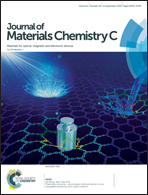A Λ-shaped cyanostilbene derivative: multi-stimuli responsive fluorescence sensors, rewritable information storage and colour converter for w-LEDs†
Abstract
A new Λ-shaped α-cyanostilbene derivative (TSA) containing an active amino group with fluorescence emission both in solution and the solid state was designed, synthesized and characterized. Its colour and fluorescence emission can be switched by external stimuli including acid/base, trinitrophenol (picric acid, PA) and grinding. The 1H NMR spectra of TSA were recorded before and after alternately adding trifluoroacetic acid (TFA) and triethylamine (TEA), which confirmed that acidichromism originated in the transformation of protonation/deprotonation between TSA and TSA-H+. Powder X-ray diffraction (PXRD), differential scanning calorimetry (DSC) and scanning electron microscopy (SEM) revealed the crystalline–amorphous state transformation between the original and ground compounds, and this transformation could reasonably account for the mechanochromic (MFC) luminescence properties. The results revealed that TSA can be used as a fluorescence sensor for acid/base and PA, and as a rewritable information storage material. Moreover, it can also be applied in white light-emitting diodes (w-LEDs) based on its desirable fluorescence emission in the solid state.



 Please wait while we load your content...
Please wait while we load your content...